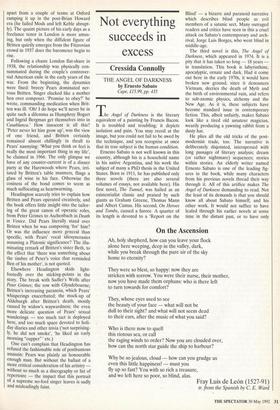Not everything succeeds in excess
Cressida Connolly
THE ANGEL OF DARKNESS by Ernesto Sabato Cape, £15.99, pp. 435 The Angel of Darkness is the literary equivalent of a painting by Francis Bacon. It is troubled and troubling; it depicts isolation and pain. You may recoil at the image, but you could not fail to be awed by the technique, and you recognise at once that its true subject is the human condition.
Ernesto Sabato is not well known in this country, although his is a household name in his native Argentina, and his work the subject of many a PhD thesis in the United States. Born in 1911, he has published only three novels (there are also several volumes of essays, not available here). His first novel, The Tunnel, was hailed as an existentialist classic and praised by such giants as Graham Greene, Thomas Mann and Albert Camus. His second, On Heroes and Tombs, caused a furore. A quarter of its length is devoted to a 'Report on the Blind' — a bizarre and paranoid narrative which describes blind people as evil members of a satanic sect. Many outraged readers and critics have seen in this a cruel attack on Sabato's contemporary and arch- rival, Jorge Luis Borges, who went blind in middle-age.
The third novel is this, The Angel of Darkness, which appeared in 1974. It is a pity that it has taken so long — 18 years in translation. This book is labyrinthine, apocalyptic, ornate and dark. Had it come out here in the early 1970s, it would have broken new ground, since it denounces Vietnam, decries the death of Myth and the birth of environmental ruin, and refers to sub-atomic physics, alchemy and the New Age. As it is, these subjects have become standard issue in contemporary fiction. This, albeit unfairly, makes Sabato look like a tired old amateur magician, wearily producing a yawning rabbit from a dusty hat.
He plies all the old tricks of the post- modernist trade, too. The narrative is deliberately disjointed, interspersed with long passages of literary analysis; dream (or rather nightmare) sequences; stories within stories. An elderly writer named Ernesto Sabato is one of the leading fig- ures in the book, while many characters from his previous novels thread their way through it. All of this artifice makes The Angel of Darkness demanding to read. Not the least of its demands is that you should know all about Sabato himself, and his other work. It would not suffice to have leafed through his earlier novels at some time in the distant past, or to have only
















































 Previous page
Previous page